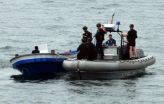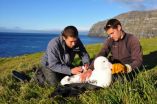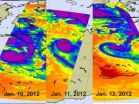(Press-News.org) The ability to catch international smugglers and terrorists just got upgraded with a Jan. 12 demonstration of collaborative software funded by the Office of Naval Research (ONR).
The Mission-Focused Autonomy (MFA) program was put into practice for the Joint Interagency Task Force (JIATF) South in Key West, Fla., during an exercise dubbed "Marathon." The collaborative information discovery and knowledge-sharing tools sift through government agency databases to support efforts by federal law enforcement for information on foreign nationals intent on harming national security and those smuggling drugs and weapons.
The software is expected to prove invaluable to Sailors and Marines, for whom "everything is dependent on what you know—and when you know it—about your adversary," said Dr. Allen Moshfegh, program manager for ONR's MFA program, part of the Command, Control Communications, Computers, Intelligence, Surveillance, and Reconnaissance department. "The more rapidly we know about our enemies—their know-how, tactics and state-of-the art technologies—the better we are prepared and therefore can make the right decisions."
MFA fosters collaboration among organizations reluctant to share information due to its sensitivity, their differing policies and procedures, and the resources expended in attaining it. The system finds information from different agencies without having to reveal confidential or proprietary data. The software searches participating agencies' databases and returns either information—documents, photos, videos, etc.—cleared for sharing or confirmation that further material is available within a particular database.
"The goal is to develop a trustworthy system that pulls data and connects the dots for humans, who are the final decision makers on whether to allocate assets for further action," Moshfegh said. "It's a tool that speeds up the decision-making process by orders of magnitude, providing the right information at the right time to put scarce ships and airplanes in place."
MFA also can be tailored for various layers of command hierarchy, from the 'big picture' view needed by a senior leader to an in-depth, operational-level view. "The objective is to decompose a complex problem into something simple," Moshfegh said.
The system runs on ONR's Command and Control Rapid Prototyping Capability (C2RPC) software, which was designed to pull together large amounts of data from disparate sources, sift and validate it. It was funded by ONR and developed by ONR, the U.S. Pacific Fleet and the Program Executive Office for Command, Control, Communications, Computers and Intelligence.
"With C2RPC we have seen enormous manpower and time savings," said Gary Toth, ONR program manager for command and control, who spearheaded C2RPC. "It minimizes the amount of time spent in information gathering and coordination, so you spend that time actually making decisions and executing a variety of mission outcomes."
To test MFA, ONR partnered with JIATF South, a multi-agency command that focuses on drug interdiction and also serves as an elite counterterrorism organization for U.S. Southern Command. JIATF South wanted help assessing tips and clues quickly and accurately, making decisions and monitoring events on the ground.
This demonstration is the first in a series, and it is part of a multi-phase process where cycles of research and development are followed by testing. "Each phase lasts approximately one year and contains three demonstrations to ensure that the research progresses in line with customer needs and requirements," Moshfegh said.
INFORMATION:
About the Office of Naval Research
The Department of the Navy's Office of Naval Research (ONR) provides the science and technology necessary to maintain the Navy and Marine Corps' technological advantage. Through its affiliates, ONR is a leader in science and technology with engagement in 50 states, 30 countries, 1,035 institutions of higher learning and more than 900 industry partners. ONR employs approximately 1,065 people, comprising uniformed, civilian and contract personnel, with additional employees at the Naval Research Lab in Washington, D.C.
ONR's information discovery and sharing environment undergoes 'Marathon' experiment
Collaborative software will help catch international smugglers and terrorists
2012-01-13
ELSE PRESS RELEASES FROM THIS DATE:
Largest bird alters its foraging due to climate change
2012-01-13
Paris/ Leipzig. Wandering albatrosses have altered their foraging due to changes in wind fields in the southern hemisphere during the last decades. Since winds have increased in intensity and moved to the south, the flight speed of albatrosses increased and they spend less time foraging. As a consequence, breeding success has improved and birds have gained 1 kilogram. These are the results of the study of an international research team published in the latest issue of the Science journal. However, these positive consequences of climate change may last short if future wind ...
Graphene quantum dots: The next big small thing
2012-01-13
A Rice University laboratory has found a way to turn common carbon fiber into graphene quantum dots, tiny specks of matter with properties expected to prove useful in electronic, optical and biomedical applications.
The Rice lab of materials scientist Pulickel Ajayan, in collaboration with colleagues in China, India, Japan and the Texas Medical Center, discovered a one-step chemical process that is markedly simpler than established techniques for making graphene quantum dots. The results were published online this month in the American Chemical Society's journal Nano ...
Deaf sign language users pick up faster on body language
2012-01-13
Deaf people who use sign language are quicker at recognizing and interpreting body language than hearing non-signers, according to new research from investigators at UC Davis and UC Irvine.
The work suggests that deaf people may be especially adept at picking up on subtle visual traits in the actions of others, an ability that could be useful for some sensitive jobs, such as airport screening.
"There are a lot of anecdotes about deaf people being better able to pick up on body language, but this is the first evidence of that," said David Corina, professor in the UC ...
How the brain routes traffic for maximum alertness
2012-01-13
A new UC Davis study shows how the brain reconfigures its connections to minimize distractions and take best advantage of our knowledge of situations.
"In order to behave efficiently, you want to process relevant sensory information as fast as possible, but relevance is determined by your current situation," said Joy Geng, assistant professor of psychology at the UC Davis Center for Mind and Brain.
For example, a flashing road sign alerts us to traffic merging ahead; or a startled animal might cue you to look out for a hidden predator.
When concentrating on a specific ...
Breakthrough model reveals evolution of ancient nervous systems through seashell colors
2012-01-13
PITTSBURGH—Determining the evolution of pigmentation patterns on mollusk seashells—which could aid in the understanding of ancient nervous systems—has proved to be a challenging feat for researchers. Now, however, through mathematical equations and simulations, University of Pittsburgh and University of California, Berkeley, researchers have used 19 different species of the predatory sea snail Conus to generate a model of the pigmentation patterns of mollusk shells.
"There is no evolutionary record of nervous systems, but what you're seeing on the surface of seashells ...
Study finds chlorophyll can help prevent cancer - but questions traditional research methods
2012-01-13
CORVALLIS, Ore. – A recent study at Oregon State University found that the chlorophyll in green vegetables offers protection against cancer when tested against the modest carcinogen exposure levels most likely to be found in the environment.
However, chlorophyll actually increases the number of tumors at very high carcinogen exposure levels.
Beyond confirming the value of chlorophyll, the research raises serious questions about whether traditional lab studies done with mice and high levels of toxic exposure are providing accurate answers to what is a real health risk, ...
Anthrax capsule vaccine protects monkeys from lethal infection
2012-01-13
Vaccination with the anthrax capsule—a naturally occurring component of the bacterium that causes the disease—protected monkeys from lethal anthrax infection, according to U.S. Army scientists. The study, which appears in the Jan. 20th print edition of the journal VACCINE, represents the first successful use of a non-toxin vaccine to protect monkeys from the disease.
Bacillus anthracis, the bacterium that causes anthrax, is recognized as one of the most serious bioterrorism threats. It produces three main components that allow it to do harm—lethal toxin, edema toxin, ...
NIH scientists identify novel approach to view inner workings of viruses
2012-01-13
Since the discovery of the microscope, scientists have tried to visualize smaller and smaller structures to provide insights into the inner workings of human cells, bacteria and viruses. Now, researchers at the National Institute of Arthritis and Musculoskeletal and Skin Diseases (NIAMS), part of the National Institutes of Health, have developed a new way to see structures within viruses that were not clearly seen before. Their findings are reported in the Jan. 13 issue of Science.
Cryo-electron microscopy (cryo-EM) is a technique that allows scientists to image very ...
The microbiome and disease: Gut bacteria influence the severity of heart attacks in rats
2012-01-13
Bethesda, MD—New research published online in the FASEB Journal (http://www.fasebj.org) suggests that the types and levels of bacteria in the intestines may be used to predict a person's likelihood of having a heart attack, and that manipulating these organisms may help reduce heart attack risk. This discovery may lead to new diagnostic tests and therapies that physicians use to prevent and treat heart attacks. In addition, this research suggests that probiotics may be able to protect the heart in patients undergoing heart surgery and angioplasty.
"Our discovery is a ...
Tropical Storm Heidi's temperature, cloud heights and rainfall grabbed by NASA satellites
2012-01-13
NASA satellites got a look inside Tropical Storm Heidi over the last several days and provided data that enabled forecasters at the Joint Typhoon Warning Center to know she was going to strengthen before making landfall, and she did.
Two instruments on NASA's Aqua satellite and two instruments on NASA's TRMM satellite provided forecasters with the rate at which rain was falling within Heidi, cloud heights and cloud and sea surface temperatures. All of those factors are added together to determine the behavior of a tropical cyclone. NASA data showed warm sea surface temperatures ...
LAST 30 PRESS RELEASES:
Estimating unemployment rates with social media data
Climate policies can backfire by eroding “green” values, study finds
Too much screen time too soon? A*STAR study links infant screen exposure to brain changes and teen anxiety
Global psychiatry mourns Professor Dan Stein, visionary who transformed mental health science across Africa and beyond
KIST develops eco-friendly palladium recovery technology to safeguard resource security
Statins significantly reduce mortality risk for adults with diabetes, regardless of cardiovascular risk
Brain immune cells may drive more damage in females than males with Alzheimer’s
Evidence-based recommendations empower clinicians to manage epilepsy in pregnancy
Fungus turns bark beetles’ defenses against them
There are new antivirals being tested for herpesviruses. Scientists now know how they work
CDI scientist, colleagues author review of global burden of fungus Candida auris
How does stroke influence speech comprehension?
B cells transiently unlock their plasticity, risking lymphoma development
Advanced AI dodel predicts spoken language outcomes in deaf children after cochlear implants
Multimodal imaging-based cerebral blood flow prediction model development in simulated microgravity
Accelerated streaming subgraph matching framework is faster, more robust, and scalable
Gestational diabetes rose every year in the US since 2016
OHSU researchers find breast cancer drug boosts leukemia treatment
Fear and medical misinformation regarding risk of progression or recurrence among patients with breast cancer
Glucagonlike peptide-1 receptor agonists and asthma risk in adolescents with obesity
Reviving dormant immunity: Millimeter waves reprogram the immunosuppressive microenvironment to potentiate immunotherapy without obvious side effects
Safety decision-making for autonomous vehicles integrating passenger physiological states by fNIRS
Fires could emit more air pollution than previously estimated
A new way to map how cells choose their fate
Numbers in our sights affect how we perceive space
SIMJ announces global collaborative book project in commemoration of its 75th anniversary
Air pollution exposure and birth weight
Obstructive sleep apnea risk and mental health conditions among older adults
How talking slows eye movements behind the wheel
The Ceramic Society of Japan’s Oxoate Ceramics Research Association launches new international book project
[Press-News.org] ONR's information discovery and sharing environment undergoes 'Marathon' experimentCollaborative software will help catch international smugglers and terrorists


